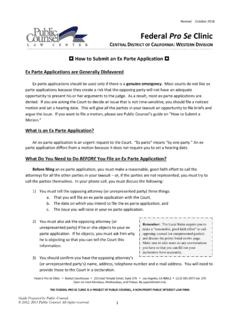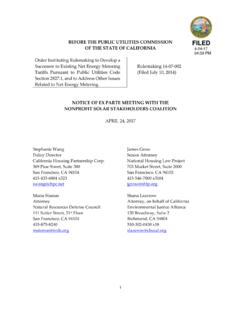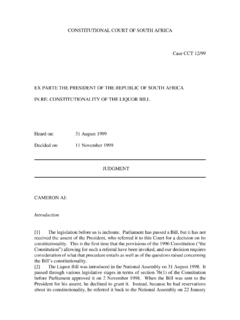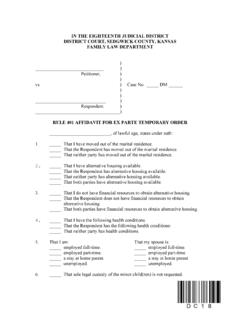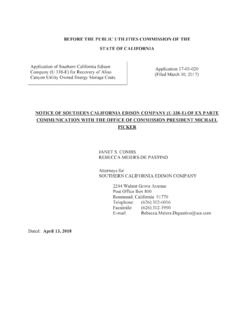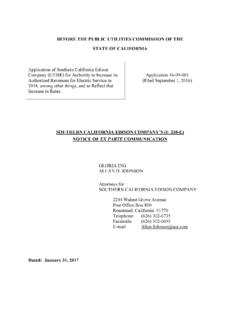Transcription of The Introduction of Negative Claim Limitations …
1 The Introduction of Negative Claim Limitations During ex parte Prosecution: 35 112 and the Issue of Antecedent Support Steven J. Hultquist Frequently, in the course of prosecuting patent applications, the patent solicitor, in the effort to patentably distinguish claims over prior art, gives consideration to inclusion in the claims of Negative Limitations . Such Limitations , by expressly excluding from the scope of the claimed invention features which are taught or suggested by the prior art, provide a potentially effective means for the patent solicitor to overcome prior art rejections of anticipation and obviousness, with the appertaining argument for patentability over the prior art that "they have [or suggest]. it, we exclude it.". Alternatively, a Patent and Trademark Office (PTO) Examiner, seeking to expedite the disposition of a patent application, may suggest the inclusion of Negative Limitations in claims under examination for the same reason, viz., that such Negative Limitations clearly and effectively distinguish the applicant's invention, and thus provide the Examiner with the basis for a cogent explanation of patentability in his or her statement of the reasons for allowance.
2 This article examines some of the problems which arise in the practice of introducing Negative Claim Limitations during the prosecution of patent applications, in the context of PTO acceptance and case law treatment of Negative Claim Limitations . The article then focuses on anomalies in Negative Claim limitation practice, relative to (i). prosecution practice involving "open ended" and "closed ended" Claim language, and (ii). Markush claiming practice. A common sense synthesis of the conflicting considerations and approaches is considered, and a suggested approach is advanced for determining when and to what extent Negative Claim Limitations should be permissible and properly employed. I. Definition and Utility of Negative Claim Limitations As used herein, the term " Negative limitation" refers to a Claim recitation which specifically excepts a particular element, composition, structure, sub-assembly, step, or other feature from the claimed invention. Illustrative examples of Negative Limitations include the following.
3 In the absence of an accelerator curingly effective for said ;..devoid of any edge surface protrusions..;..without annealing said alloy prior to said passivation treatment thereof ;..said laminated web not including any embossments on marginal portions thereof . It is readily apparent that Negative Limitations can provide a satisfactory terminology for effectively distinguishing claimed inventions from prior art, in a manner which is very specific to the prior art and thus does not otherwise excessively narrow the scope of protection obtainable on the invention. Taking as an illustrative example the aforementioned recitation .."devoid of any edge surface protrusions.. thereon," it is possible to differentiate the claimed invention from prior art structures characterized by edge surface protrusion elements, while at the same time leaving the Claim open to coverage of other edge surface geometries, , concavely dimpled edge surfaces, which would otherwise be outside the literal scope of the Claim , if a positive limitation such as ".
4 Having smooth edge surface portions " were instead employed. II. Pre-Filing Incorporation of Antecedent Specification Basis for Negative Claim Limitations vs. Introduction Thereof During ex parte Prosecution Without Antecedent Specification Basis: Problems and Tactics It is a fundamental requirement of Claim drafting practice that the claims of a patent (application) must be consistent with and supported by the specification, in order to comply with the requirements of 35 112, with regard to the so-called "enabling disclosure" and "particular pointing out and distinctly claiming" provisions of the statute. In the circumstances where the patent solicitor is knowledgeable of pertinent art and drafts the patent specification to provide express support for a potentially distinguishing Negative limitation, , so that the specification contains an explicit statement of the Negative limitation, then there is a direct antecedent support in the specification for appertaining Negative limitation Claim terminology.
5 In many instances, however, the patent solicitor first becomes aware of prior art which is distinguishable via Negative Claim Limitations , during the course of prosecution, after the patent application has been filed, and without any express statement of the Negative limitation in the as-filed specification. Under such circumstances, the patent solicitor is faced with a conflict. If he or she introduces a Negative Claim limitation, the same may be operative on its face to clearly distinguish the claimed in- vention from the otherwise problematic prior art, but the Examiner may take the position that such Negative Claim limitation is not sup- ported by a corresponding explicit statement of the Negative limitation in the specification and thus constitutes "new matter" under 35 132. At this point, the patent solicitor typically is reduced to arguing that such Negative limitation is implicit in the disclosure (adopting an "inherency" hypothesis), or else refiling the patent application, , as a continuation-in-part (CIP), to expressly set forth in the specification the Negative limitation sought to be included in the claims.
6 Both of these courses are fraught with potential risks. In the former case, the Examiner may remain unpersuaded that the Negative limitation sought to be introduced into the Claim (s) is adequately supported in the specification in compliance with 112 and 132. requirements. In the latter case, there is, in the act of refiling to include the express statement of the Negative limitation to the specification, a tacit admission that the Negative limitation is not "inherent" in the originally filed disclosure, and the accompanying risk that intervening prior art or "statutory bar" events may come into play. Although the applicant may, consistent with the position that the Negative limitation is inherent in the prior disclosure, file a "continuation" application as opposed to a CIP, and identify the purpose of the continuation as "merely making express what is implicit in and intrinsic to the prior disclosure," the effect of such action, even if successful in the Patent and Trademark Office, may be nullified in subsequent litigation by a finding that the Negative limitation was in fact "added" and not "inherent.
7 ". On balance, if refiling is resorted to, it would appear to be the better strategy to denominate the refiled application containing the express statement of Negative limitation as a "continuation" and to make the appertaining inherency argument, if this is in fact a reasonable and tenable position. III. PTO Acceptance and Case Law Treatment of Negative Claim Limitations The reported cases which have construed the validity of claims in which a Negative limitation was introduced during prosecution of a patent application are comparatively few in number and not at all coherent, insofar as the ability to extract a bright line demarcation of the law from them is concerned. Historically, the Patent and Trademark Office disfavored the use of Negative Limitations in claims. The major criticism of Negative Limitations has been that they fail to meet the requirements of 35 USC 112. In one case the Court of Customs and Patent Appeals stated that Negative Limitations are an attempt to Claim an invention "by excluding what [applicant] did not invent rather than by particularly and distinctly pointing out what [applicant] did invent.
8 ". Some typical reasons why Negative Limitations are frequently criticized and rejected for failing to meet the requirements of 37 USC 112 are as follows: (1) the Negative limitation is seen to potentially prevent a person skilled in the pertinent art from making or using the invention; (2) the Negative limitation makes the Claim indefinite or too broad; or (3). the exception associated with the Negative limitation is not disclosed in the specification as required by Patent Office Rule 75(d) (1). There are situations, however, when Negative Limitations are the only way to describe the invention. For example, the omission of an element may in fact be the invention. Perhaps for this reason the Patent and Trademark Office has not made the use of Negative Limitations entirely impermissible. The Manual of Patent Examining Procedure (d) states that "the inclusion of a Negative limitation shall not, in itself, be considered a sufficient basis for objection to or rejection of a Claim ".
9 This MPEP section states, however, that a Negative limitation may be rejected on 35 USC 112 grounds. Although the use of Negative Limitations is permissible, claims which include them often do not survive rejection by Examiners and frequently fail on appeal. The cases dealing with rejections of claims on the basis of Negative Limitations are broadly categorizable into three general subject matter areas. These three areas are separately discussed below. Lack of Basis in the Invention Itself for the Negative Limitation Claims fail in cases where the Negative limitation is seemingly an overt attempt to avoid prior art when no patentable reason for the exclusion exists. One of the most often cited cases regarding Negative Limitations involving such a problem is In re Langdon. The applicant in that case attempted to avoid a prior art reference by excluding nickel from a named group of metals claimed for a metallic protective coating. The court rejected the Negative limitation Claim "excepting nickel" because there was no distinguishable (patentable) reason to exclude nickel from the named group.
10 Lack of Proper Breadth and Specificity in Claims Containing the Negative Limitation Claims which include Negative Limitations often fail because the claims are too broad and too indefinite. While seeming to exclude certain elements from a Claim (and thus apparently narrowing the scope of the Claim ), some Negative Limitations effectively broaden the Claim . In actuality, the Negative limitation may have the effect of giving the applicant an exceedingly broad scope of protection in the claimed subject matter. Three cases illustrate this point. The Court of Customs and Patent Appeals rejected claims containing Negative Limitations in In re Schechter. The claims in the application at issue in that case included two Negative Limitations . The first Negative limitation in Schechter referred to an organo substituent (R group) in a chemical formula as follows: "R is an alkenyl radical other than a 2-butenyl and 2,4- penta-dienyl". The upheld the Examiner's rejection of this Claim on the basis that the Negative limitation made the Claim indefinite, since the applicant sought to Claim what was not invented, rather than "particularly and distinctly pointing out" what was invented.

